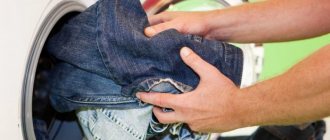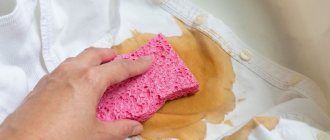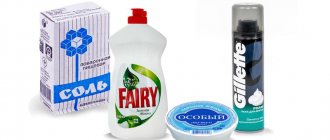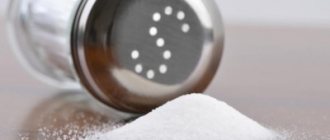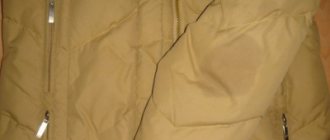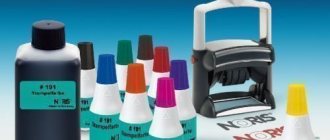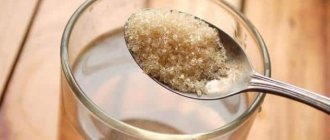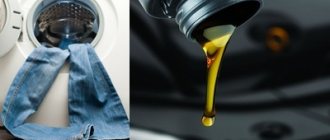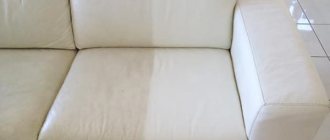In some cases, improvised and special means will help cope with the situation. Moreover, it is possible to clean even such a complex surface as concrete.
We'll tell you in this article how to remove machine oil stains from clothes, asphalt, concrete, and paving slabs.
Where to begin?
Most often, clothes suffer from oil stains. An accidental mark can lead to the fact that an otherwise good piece of clothing will simply have to be thrown away. To prevent this from happening, it is advisable to begin removing traces of technical fluids as soon as possible.
It is important to adhere to two main recommendations:
- Localize where engine oil gets on the surface, preventing it from spreading over a larger area.
- Prevent oil from absorbing into the material. To do this, use preparations that can absorb the spilled product.
It is recommended to sprinkle a fresh stain on top as quickly as possible:
- salt,
- talc,
- chalk,
- starch or other powder that will slow down the absorption of oil into the surface.
After the grease has been absorbed, the powder is collected and work begins to remove traces of spilled engine oil.
It is recommended to use absorbent products in all cases where oil has been spilled. Regardless of the type of surface material.
We recommend
DOCKER MAZBIT TURBO is a concentrated industrial cleaner for all types of heavy contaminants. Designed for effective quick cleaning of any surfaces: parts, components, mechanisms, plastics, general construction materials (concrete, stone, tiles, asphalt) from various oil-fat and petroleum contaminants, fuels and lubricants, lubricants, graphite, fuel oil, oil. Has no smell. No acid.
More details
How to remove machine oil from asphalt How to remove oil from concrete How to remove machine oil from a concrete floor
How to remove using traditional methods?
You can try to remove traces left by machine oil using improvised means.
Laundry soap
Soap is the most gentle way to remove stains, but a good result is only possible if the stain is fresh. Procedure:
- rub the affected area with soap;
- put the item aside for 3 hours;
- rub the treated area intensively with a brush using hot water;
- wash in the usual way.
Re-processing may be necessary.
Dishwashing gel
A gel containing fat-soluble components can help remove stains, but only if a little time has passed.
Application procedure:
- Apply the product generously so that the gel covers the entire stained area and saturates the fabric.
- Leave for at least 2-3 hours.
- Rub with a brush.
- Rinse.
- Wash the product.
Toothpaste
For fresh stains, toothpaste can be used. The product is applied generously to the area, rubbed, and after a couple of hours washed in warm water.
Toothpaste will not cope with old traces of oil , but it can discolor the material at the site of application if the exposure was long enough.
Ammonia
Ammonia is often used as a solvent. Before use, the drug must be diluted with warm water in a 1:1 ratio. The material is actively moistened with the solution and left to act for 15-30 minutes. After which they wash it.
It is possible to remove machine oil stains in this way only if they are fresh.
Ironing
You can try to eliminate the oil by heating the affected tissue. For these purposes, you will need paper napkins with high absorbency.
Procedure:
- place the napkins on both sides of the area of contamination;
- iron the fabric through several napkins;
- Continue the process, replacing soiled napkins with clean ones as necessary.
Heating fabric stained with machine oil may be accompanied by the release of a specific unpleasant odor.
Petrol
Refined gasoline can be used as a solvent. Baking soda and liquid soap are also useful for removing stains.
Procedure:
Combine liquid soap and gasoline in equal proportions.- Stir.
- Apply the composition to the stain.
- Leave to act for 1-1.5 hours.
- Rinse off.
- Sprinkle baking soda on the contaminated area.
- Leave for 10-15 minutes.
- Rinse off.
- Wash.
Kerosene or acetone can be used instead of gasoline.
Methods for removing stains depending on the type of fabric - table
| Fabric type | Color | Methods for removing fresh stains | Ways to remove old stains |
| Cotton | White | Dishwashing liquid, ammonia. | Professional bleaches: Profoam, Bioklin S, etc. |
| Black | Dishwashing liquid, laundry soap, salt. | Professional products: K2r, Dr. Beckmann | |
| Color | |||
| Linen | White | Chalk, salt, ammonia, dishwashing detergent. | Professional bleaches: Profoam, Bioklin S, etc. |
| Black | Tar and laundry soap, starch, mustard. | Professional products: K2r, Dr. Beckmann | |
| Color | |||
| Jeans | White | Dishwashing liquid, starch, salt, chalk. | Turpentine + ammonia, gasoline + professional products. |
| Black | Tooth powder, butter, dish soap. | Professional bleaches: Profoam, Bioklin S, K2r, Dr. Beckmann et al. | |
| Color | |||
| Synthetics | White | Laundry or tar soap + dishwashing detergent. | Professional stain remover: Dr. Beckmann |
| Black | Washing powder + water, dishwashing detergent. | ||
| Colored | |||
| Silk | White | Turpentine + ammonia, chalk, salt, starch. | Dishwashing detergent + laundry soap |
| Black | Dishwashing liquid, mustard, salt. | Dishwashing detergent+powder | |
| Color | |||
| Wool | White | Butter, salt, sugar, talc. | Gasoline, turpentine + ammonia, K2r |
| Black | Mustard, tar soap, starch. | K2r+washing powder | |
| Colored | |||
| Genuine Leather | Light | Talc, salt, starch. | Dishwashing liquid |
| Dark | Mustard | ||
| Leatherette | White | Talc, starch, salt, sugar. | Gasoline, Dr. Beckmann |
| Black | |||
| Color |
How to remove with special preparations?
Even such complex marks that machine oil leaves on clothes can be removed. For these purposes, stain removers are used that are active against greasy marks from technical fluids.
Dr. Beckmann
The stain remover made in Germany is available in liquid form in small packages. The product is suitable for removing marks left on fabric:
- machine lubricant,
- oil,
- bitumen.
The drug can be used to treat things of adults and children.
For the composition to work, the stain is well wetted, covered, and the product is allowed to lie. In this case, the surface of the fabric should not dry out. As a result of processing, machine oil dissolves and can be removed with tampons and napkins. The area of material is wiped with a rag. After the oil is removed, the textiles are washed.
The product is not suitable for treating carpeting and leather items . The average price is from 200 rubles per bottle.
Astonish Oxy Active Plus
The drug, produced in Great Britain, is available in concentrated form. The product contains no phosphates. The powder can be used to wash clothes for children and adults made from various types of fabrics.
Astonish powder can be used to remove difficult and old stains. In addition to clothes, the stain remover helps clean:
- furniture upholstery,
- floor and wall tiles,
- carpets and other surfaces.
The product comes with a measuring spoon, which makes dosing easier. Price – from 150 rubles per 0.5 kg package.
Liqui Moly Auto-Innenraum-Reinger
Automotive cosmetics - car interior cleaners - work well with machine oil on fabrics and other surfaces. The drug TM Liqui Moly is available in liquid form in bottles with a sprayer. It removes traces of machine oil well and refreshes the material.
To clean the fabric from stains, the product is sprayed onto the problem area, and this action is repeated if necessary . During the cleaning process, do not allow the liquid to dry on the material. Price – from 800 rubles.
How to clean different types of fabrics?
When starting to remove an oil stain, you need to consider the type of clothing and type of material. Both improvised and special means can be used.
Cotton, linen
To remove oil from natural fabrics, you can use simple folk recipes. Even dishwashing gel gives good results if you use it while the stain is fresh.
Without pre-treating the stained area, items should not be washed in hot water. Otherwise, the stain will be very difficult to remove.
Jeans
Denim material has a high density of fiber weave. Oil that gets on jeans is quickly absorbed and difficult to remove. To treat such fabric, it is better not to use soap or dish gel, but rather more aggressive solutions. For example, based on acetone or gasoline. It is recommended to treat the material with solutions from the reverse side.
Suede
You will have to remove oil from suede in several stages, working gradually.
It is possible to use any of the methods that does not stain or discolor the material, and also does not spoil the texture of the suede. This could be ammonia or gasoline .
The solvent should be used sparingly, without spreading the stain over the surface of the material. At the end of the process, it is better to wash off the remnants of the products that were used to remove oil with a soap solution, and treat the suede with a special product.
Outerwear
To remove oil from jackets and other things, gasoline, laundry soap, dishwashing gel and other available products can be used.
Treatment should begin by removing excess oil and preventing the grease from spreading to the interior and lining. In difficult cases, you will have to prop up the lining in order to have access to the problem area from both sides.
It can be very difficult to clean up membrane and other things after oil stains, and the result is not guaranteed. An alternative approach is to dry clean your outerwear.
Leather
Any stains from natural leather should be removed as carefully as possible, avoiding intense exposure. To remove stains , soap, gasoline, and dishwashing gel can be used . After finishing the treatment, the skin must be treated with a special product.
This video will show you how to remove machine oil stains from clothes:
Fresh spots
It is much easier to solve the problem if the stain has just been planted and you quickly begin to eliminate it. When oil gets on clothes, it is very important to minimize the time it remains there, that is, not to allow it to be deeply absorbed. Otherwise it will be much more difficult to wash.
In the first minutes, and sometimes even seconds, it is recommended to pour any absorbent powders and products onto the stain. This should include:
- chalk;
- dentifrice;
- dry mustard in powder form;
- salt;
- starch, etc.
All these products have good absorbent properties. Therefore, when applied, they will begin to take oil and other similar liquids from the fabric.
If the stain is very fresh and the absorption process has just begun, then blot the clothing with a dry cloth, cotton pad or toilet paper. At this stage, the task is to prevent the oil that still remains on the surface of the product from being absorbed.
When you have dampened the cloth with paper and also poured in the powder, remove the remaining product. Then you can start washing. Moreover, here you should use water at the maximum temperature that the fabric can withstand. The tags usually indicate at what temperature a particular product should be washed.
After soaking the material in water, carefully go over the stain with a piece of laundry soap. Wash it off with a soft brush or sponge. After this, it is important to pour one of the powders listed above again, let the remaining oil be absorbed, soak in water again and treat with laundry soap. If a large amount of oil gets on your clothes, then it is better to repeat this procedure several times.
The job is completed by sending the product to the washing machine. Moreover, it is recommended to wash in the mode intended specifically for this clothing. It is not recommended to add other clothes to the drum that do not have any traces of oil on them.
But there are situations when there is no chalk nearby, and some powders from the list are also missing. I definitely have toothpaste at home. You should take advantage of its properties. But it is important that the paste is plain white, without dyes. The paste should be applied to the stain, smeared a little with your fingers or a cotton pad, without going beyond the stain, and left to dry. Since the paste has good adsorbing properties, it copes well with fresh oil stains. When the paste dries, you need to moisten it and gently brush it with a toothbrush. Then you send the clothes to the wash.
You should not completely rely on modern powders and other similar washing products. In rare cases, they will cope with contamination in the form of motor oil on their own. Therefore, it is recommended to first get rid of the bulk of the lubricant using the indicated methods, and then trust the washing machine and special synthetic products. With this combination of methods, the chances of success are much higher.
In some cases, WD40 aerosol is used
Features of removal from paving slabs, concrete, paving stones and asphalt
Removing technical fluids from concrete, tiles and asphalt not only allows you to maintain the aesthetics of the area around your home and garage.
Oil remaining on the coating:
- reduces its strength;
- worsens the fire safety level of the garage;
- violates the environmental friendliness of the space.
Machine oil spilled on asphalt, tiles or concrete surfaces is very difficult to clean up. This is due to the fact that high molecular weight resins in used oil easily penetrate porous surfaces.
Methods for dealing with oil drips can be divided into the following groups:
Mechanical cleaning . Brushes, scrapers, grinders and other devices are used for it.- Dry and wet cleaning . In this case, the stain is covered with sand, sawdust or soda. After sweeping, most of the oil is removed. The cleaning is completed by washing with targeted water under pressure.
- Chemical processing . Solvents are used for this.
In most cases, to achieve optimal results, it is necessary to use an integrated approach that combines several methods of influence.
This video will show you how to remove machine oil stains from paving slabs and concrete:
What not to do?
When removing engine oil, it is important to avoid these common mistakes:
- Start removing stains over time. If a lot of time has passed since the oil hit a porous surface with good absorbency, and the composition has been absorbed and fixed, it will be extremely difficult and slow to remove it completely.
- Technical oil is a difficult substance to remove. To cope with it, chemical manufacturers offer agents that are aggressive in their effects. In this case, there is a possibility of damage to the material. To prevent this from happening, any solvent must first be tested on an inconspicuous area.
- Intense friction of fabric, especially without the use of solvent. With this effect, the stain can occupy an even larger area and penetrate deeper into the material.
Mistakes when treating oil stains
Do not immediately send clothes with an oil stain to the washing machine. The oil will stain the drum and you will also have to wash the washing machine tank.
Do not rush to wash clothes with regular washing powder right away: the product will not help remove the oil, but will “seal” the stain, making it even more difficult to remove. First you need to treat the stain, and then wash it by hand or in a machine.
When preparing to wash, do not scrub the stain or use a clothes brush. Mechanical impact can ruin the fabric, and the stain will penetrate even deeper into the fibers.
Recommendations
For more efficient work, it is recommended to adhere to the following tips:
Gentle machine oil removers may have little or no effect on old stains.- Before using the solvent, you need to study the instructions for it.
- Older stains may need to be treated several times. And even in this case, the result may not be the best.
- Most engine oil solvents have an aggressive composition. In order not to spoil the item, it is recommended to test it on an inconspicuous area before using the product for the first time.
- Even after removing the stain, a specific technical aroma may remain on the clothes for some time. To completely eliminate it, the item needs to be well ventilated.
- Worn fabrics may not withstand intensive cleaning. If an item has a significant degree of wear and tear, it will simply have to be thrown away.
The result of removing an oil stain largely depends on the thickness of the composition and brand of the product, as well as how long ago the stain was placed.
If you are interested in how to remove vegetable and machine oil stains from various surfaces, take a look at this section.
Precautionary measures
When using cleaning products, adhere to the following rules:
- wear rubber gloves;
- Clean in a well-ventilated area;
- when using a special stain remover, carefully read the instructions;
- If the substance gets on mucous membranes or skin, immediately rinse the damaged area well.
If you feel dizzy, itchy in the nasopharynx, coughing or have difficulty breathing while working with chemicals, stop working immediately and take a breath of fresh air.
